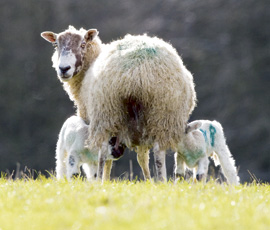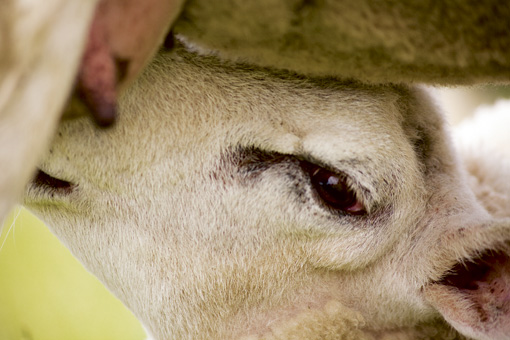Protecting your flock from clostridial diseases and pasteurella

Diseases in sheep caused by clostridial pathogens and pasteurella are particularly aggressive – the organisms are ever present in the environment and are usually fatal.
So with limited treatment options, how can producers ensure optimum protection for their sheep?
What are clostridial diseases?
Clostridial diseases are caused by bacteria that are found in the soil, where they can survive for a very long time. They can also occur naturally in the gut of healthy animals, and usually require a stress event to trigger clinical infection. There are a number of different types of clostridial disease affecting sheep, including blackleg, braxy, malignant oedema, red water disease, several types of enterotoxemias, and tetanus.
The most common infections tend to be enterotoxemia types B, C and D – lamb dysentery, bloody scours and pulpy kidney disease respectively. Lamb dysentery usually affects lambs under two weeks old, causing diarrhoea and sudden death. Bloody scours, also known as haemorrhagic enteritis, also affects lambs during the first few weeks of life, often following a sudden change in feed, and causes a bloody infection of the small intestine.
Pulpy kidney, or overeating disease, is one of the most common sheep diseases in the world, usually affecting large, fast-growing lambs from two to 12 weeks old – or from six months when left unvaccinated. It is triggered by a sudden change in feed, usually in lambs on a high-concentrate diet or nursing a heavy-milking dam.
Tetanus is usually related to docking and castrating, although any wound can be to blame. Symptoms occur up to three weeks after infection, and include hind-leg stiffness, locked jaw and convulsions. Blackleg is also related to skin wounds, resulting in dull sheep with a high temperature and poor appetite. When present in one limb, it causes sudden and severe lameness.
Black disease occurs in wet areas where liver fluke are present, infecting the liver after damage caused by fluke. Braxy is characteristically seen in unvaccinated weaned lambs during the winter months, associated with ingestion of frosted root crops. But malignant oedema, or bighead, usually affects rams during late summer when head butting is a common behaviour. The most obvious sign is marked swelling of the head, particularly around the eyes.
Almost all cases of clostridial disease are fatal – very few can be successfully treated and often the first sign of sickness is finding dead sheep.

What is pasteurella?
There are different types of pasteurella bacteria, which cause septicaemia in young lambs during the spring and summer, pneumonia in older sheep and mastitis in ewes. According to EBLEX, systemic pasteurellosis caused by Bibersteinia trehalosi is the most common cause of sudden death in lambs in the UK between August and December. In addition, pneumonia caused by pasteurellosis is the biggest killer of growing and adult sheep in the UK.
It is a disease that occurs sporadically, without warning, and often kills one in 10 animals when an outbreak occurs. However, it can be found in up to 95% of healthy sheep, and is only triggered when stress factors lower their disease resistance. Presence of other infections can play an important role, and mycoplasmas are a major underlying problem, impacting on the effectiveness of vaccines as well as triggering full-blown disease.
Pasteurellosis can be treated with antibiotics when caught early enough, but often the disease results in rapid mortality, making treatment generally ineffective.
How can I protect my flock?
The only way to protect against clostridial diseases and pasteurella is to vaccinate both adult sheep and lambs, says ADAS sheep consultant Kate Phillips. Surprisingly, almost 20% of producers do not have a regular vaccine programme. “I’ve seen quite high losses during the grazing season when people haven’t vaccinated their lambs. But you have also got to make sure your ewes are covered properly, by giving a booster vaccine four to six weeks before lambing.”
This ensures ewes pass on immunity to their lambs through colostrum. “It is important ewes are fed well, so they develop a rich supply of colostrum. When you’re lambing over a long period, it might be best to stagger the vaccines for optimum efficacy.”
However, lambs’ acquired immunity to pasteurella lasts for only the first three to four weeks of life, with immunity to clostridial diseases waning after 10 to 12 weeks. It is therefore essential to vaccinate lambs before these danger periods, warns independent vet Paul Roger.
“In unvaccinated flocks, lamb dysentery is a very high risk – it can decimate flocks and there’s nothing you can do.” Lambs are only capable of developing their own antibodies from about 30 days old, so usually the earliest you can vaccinate is four weeks of age, although single pasteurella vaccines can be given from 14 days. A second dose must be given about four weeks later to boost immunity logarithmically. “There is no point only giving one dose – it just won’t work.”
Immunity takes two weeks to develop, so lambs should be covered from eight to 10 weeks old – although vaccines are not 100% effective. Boosters should then be given annually for clostridial diseases, or up to every six months for pasteurella. Both vaccines can be administered together, but may not cover the whole spectrum of clostridial diseases. “It’s really important you undertake a risk assessment as to what the environment is likely to throw at your animals.”
Previous problems in certain pastures are a good indication of potential infection, while targeting boosters ahead of risky times of the year can help reduce incidence of disease. Taking steps to reduce flock stress is also helpful in reducing trigger factors. “When you have a problem with disease, stress or poor nutrition, it will suppress the lamb’s immune response.”
Therefore, minimising stress when gathering the flock for dipping, castration, dosing with wormers or moving fields is important. Warm and wet weather or cold, wet and windy weather can also predispose infection rates, as can abrupt changes in diet.
Case study: FAI Farms, Oxford
 FAI Farms has a flock of 1000 ewes at Wytham, Oxford, which suffered grumbling pasteurella problems for a number of years. But in 2009, it really came to a head – it was a bad year in terms of the weather, and they lost 50 lambs in a short period of time, says vet Ruth Clements. Although they had previously vaccinated the ewes, they had not covered the lambs. “We never had a problem with pasteurella in the first couple of months of life – it was the older lambs which suffered, as the inherited resistance from their dams dropped away.”
FAI Farms has a flock of 1000 ewes at Wytham, Oxford, which suffered grumbling pasteurella problems for a number of years. But in 2009, it really came to a head – it was a bad year in terms of the weather, and they lost 50 lambs in a short period of time, says vet Ruth Clements. Although they had previously vaccinated the ewes, they had not covered the lambs. “We never had a problem with pasteurella in the first couple of months of life – it was the older lambs which suffered, as the inherited resistance from their dams dropped away.”
Lambing in April, the flock suffered the worst of its problems post-weaning and in the second half of the summer. Most lambs developed septicaemia and died, although some were caught early and treated, with limited success. “Our post-lambing mortality had been 22%, with pasteurella almost half of that,” says Ms Clements.
However, last year they vaccinated the lambs at four and eight weeks old, and placed greater emphasis on lamb nutrition, worm control and ways to reduce stress at handling. “We wanted to improve the overall flock health status to give us the best chance of success against such a complex disease, and have cut mortality to 7%, with the pasteurella proportion down to a sixth – boosting lamb sales by £6930.”
SPONSOR’S MESSAGE

Pneumonia continues to be a significant cause of death in unvaccinated lambs under 12 months of age. The disease may occur all year round and has a variety of causes, but pasteurellosis is diagnosed in many outbreaks.
Ewes vaccinated with Heptavac-P Plus in the run-up to lambing can pass immunity to pasteurellosis on to their lambs through the colostrum, but only for up to four weeks. To ensure your lambs are fully protected against pasteurellosis this grazing season – as well as the key clostridial diseases – they should be vaccinated with Ovivac-P Plus. The primary vaccination course requires two injections four to six weeks apart.
For more details contact your vet or animal health product supplier
Flock Focus
